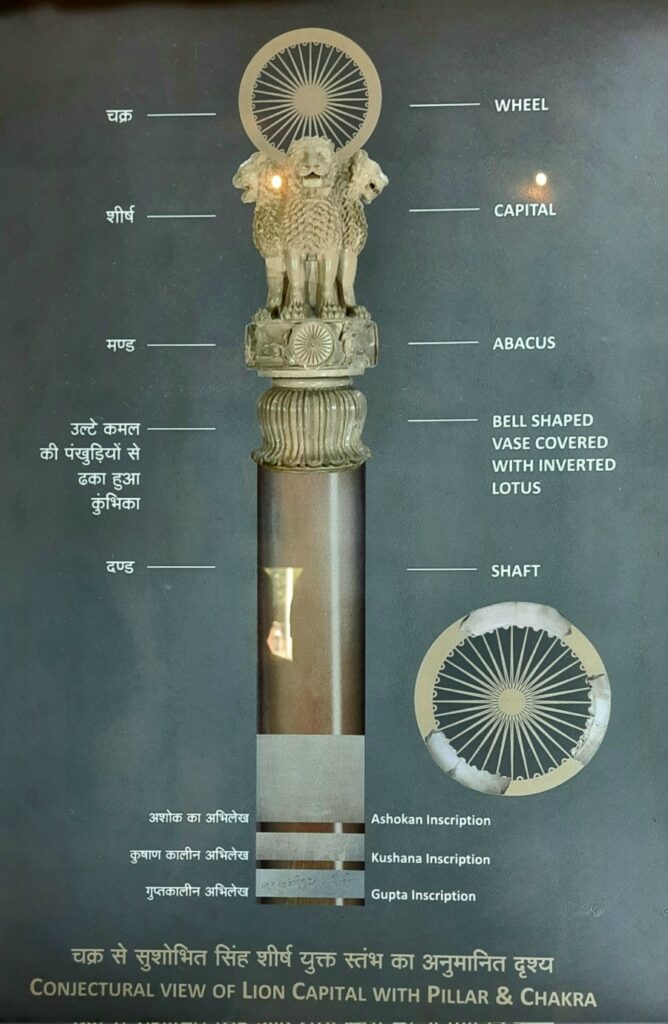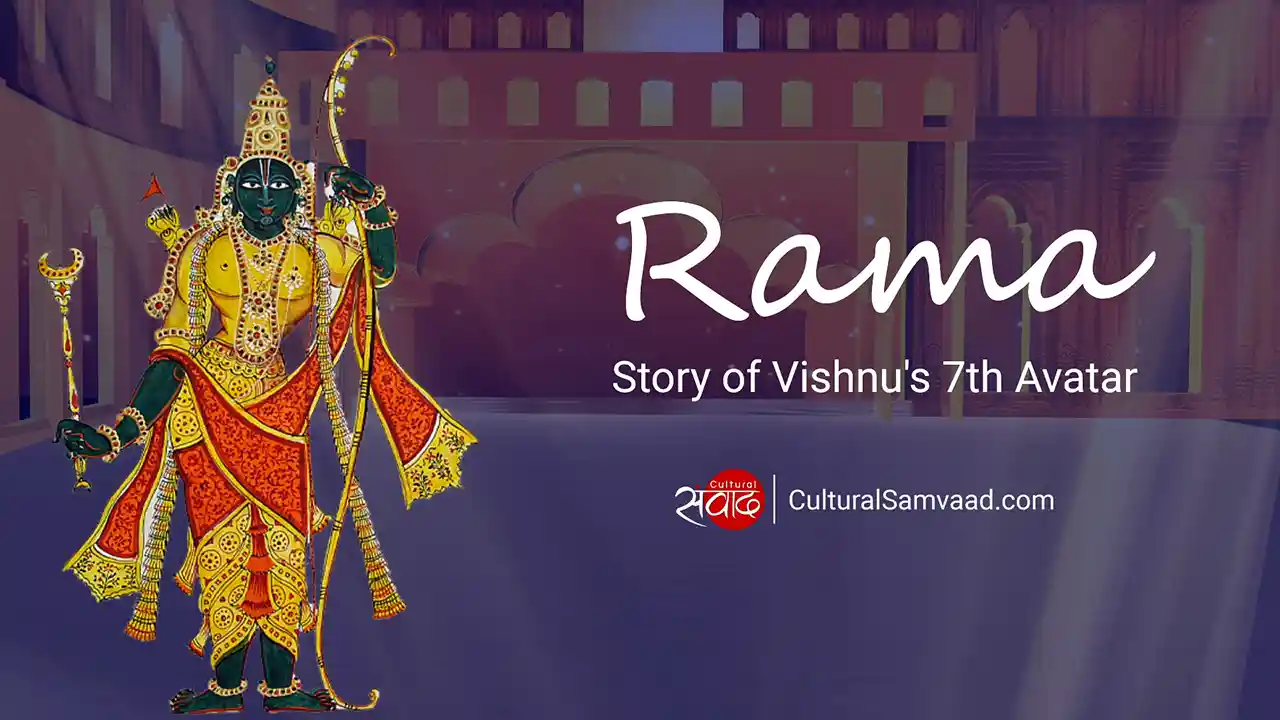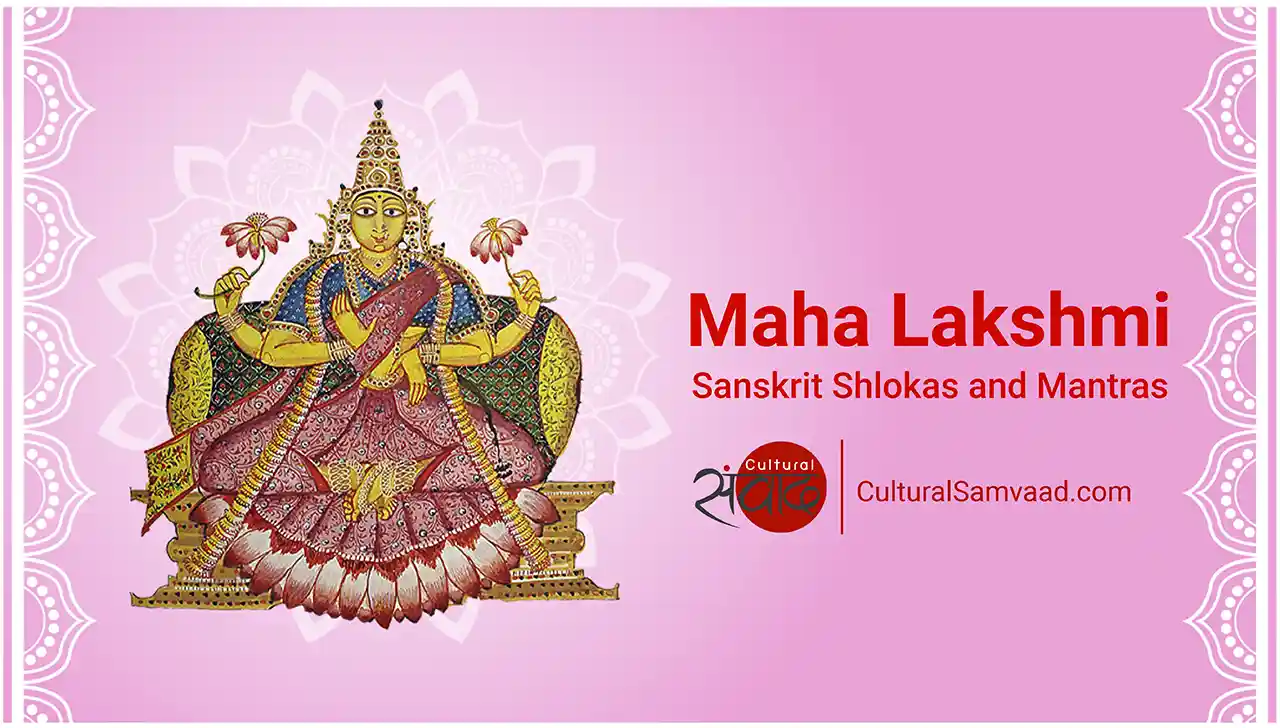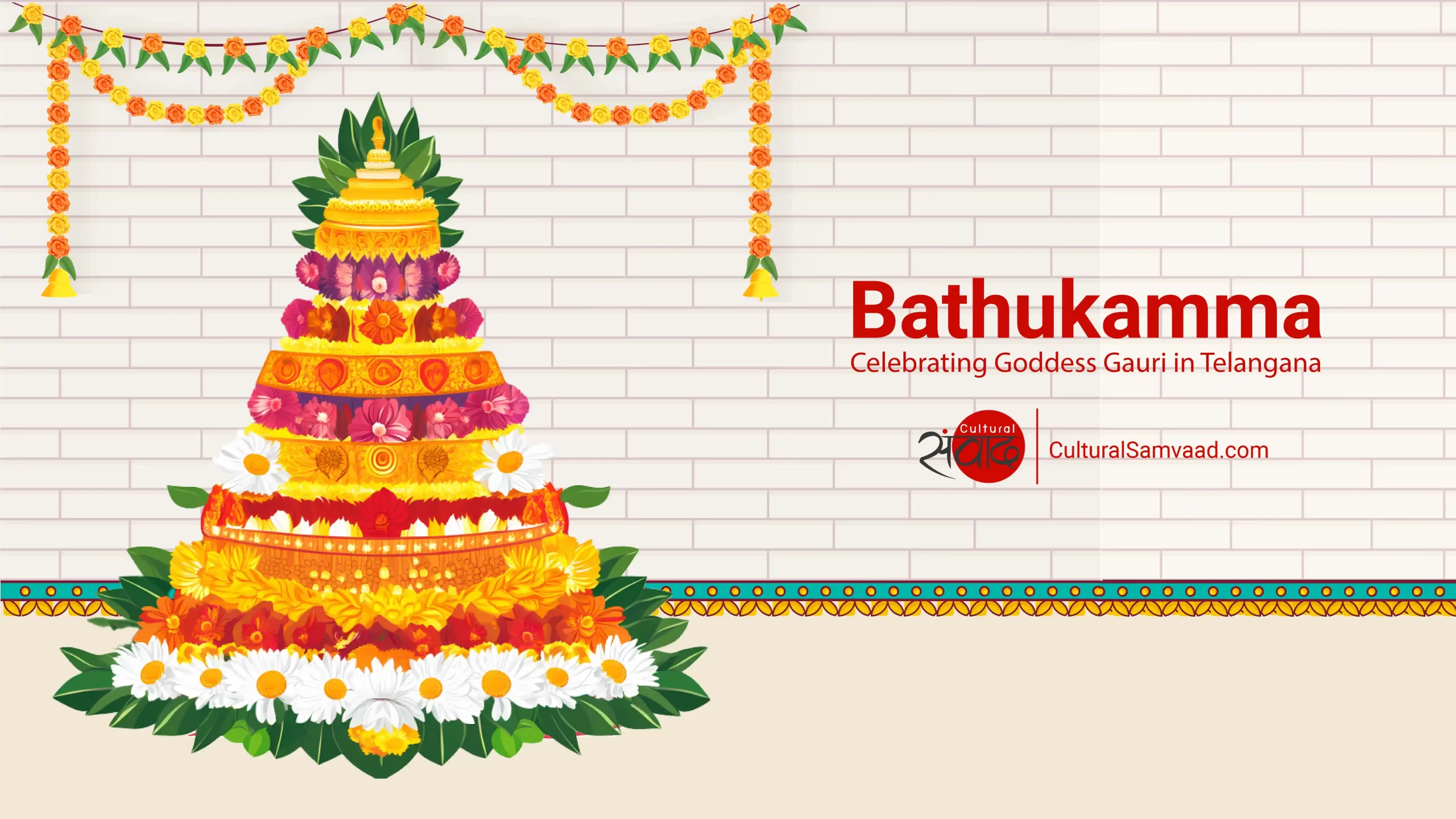Join our WhatsApp Community
The ‘Sarnath Lion Capital’ was commissioned by the Mauryan Emperor King Ashoka in the 3rd Century BCE. This towering Lion Capital (210 x 283 cms) originally stood (on the top of an Ashokan pillar) at the spot where Gautama Buddha is believed to have delivered his path-breaking first sermon after enlightenment or awakening, thereby setting the wheel of Dharma in motion (Dharmachakrapravartana).
Its existence was recorded by Chinese pilgrim Xuan Zang in his travelogue. “To the south-west of the Buddhist Temple, the pilgrim proceeds, was a ruinous old stone tope built by Asoka of which 100 feet still remained above-ground. In front of this was a stone pillar, above 70 feet high, which had the softness of jade and was of dazzling brightness. This pillar was at the spot at which the Buddha, having attained enlightenment, first preached his religion.” (Watters, 1905)
In its physical form, the Sarnath Lion Capital was lost in the sands of time and was formally excavated by F.O. Oertel during ASI’s 1904-05 excavations at Sarnath.
Today it is on view at the on-site Sarnath Archaeological Museum (Accession No. 355) in Uttar Pradesh. This masterpiece greets visitors almost as soon as they enter the museum’s built-up precincts and cannot but overawe and move every Indian for not only is the State Emblem of India (generally referred to as the National Emblem of India) adapted from the Sarnath Lion Capital but also the chakra or wheel that adorns the fluttering tricolour is inspired by it.
Brief Description of the Sarnath Lion Capital

The magnificent Lion Capital at Sarnath is carved from a single block of highly polished Chunar stone and as mentioned earlier, was part of a giant Ashokan Pillar that consisted of five component parts.
- Part I – The inscribed pillar shaft at the bottom which was also the longest part. It was found in damaged condition and fragments can be viewed at the Sarnath Archaeological site.
- Part II – A lotus bell base with 16 petals.
- Part III – A drum or circular abacus on the bell base with four 24-spoked chakras or wheels which are interspersed by four animals – an elephant, a lion, a bull and a horse, in remarkable motion on its frieze.
- Part IV – The naturalistically carved figures of four majestic lions which are seated back-to-back and mounted on the abacus (four addorsed lions).
- Part V – The crowning element, a large Dharmachakra (a wheel believed to have had 32 spokes and referred to as a maha-chakra by Agrawala) which sat atop the lions. Five fragments of this wheel and three spokes were recovered during the excavation are on display at the museum.
To the above list, we can add the ‘undressed foundation block’ in which the shaft is inserted. The shaft and the 32-spoked Dharmachakra were carved from different blocks of stone.
Symbolism of the Sarnath Lion Capital
The Lion Capital of Sarnath has had many lives, has multiple layers of meanings and of course has engaged scholars for over a century in innumerable debates as they try to decode what it was influenced by and what it influenced in turn. The multifarious elements of the Sarnath Lion Capital have been interpreted variously in the Buddhist context in particular and in the larger Indic context in general.
I feel compelled to state at this point that I see the various elements and components of the Sarnath Lion Capital in the larger continuum of the Indic civilisation and am in favour of readings that link the past to the present and are pluralistic in nature rather than stressing on exclusivist interpretations. The Buddhist tradition is as much Indic as any other tradition and was and is inextricably linked to the land. In the subsequent discussions, I have tried to present a few shades of the multiple facets of this debate. For those who would like to explore further, some of the book in the bibliography are excellent to begin with.
Let us commence our discussion with the lotus bell-shaped structure which has not been included in the State Emblem of India. There are scholars who have argued including the excavator that it is of Persepolitan style (for the uninitiated – it refers to Persepolis). Coomaraswamy believed that Indian artists had independently arrived at this form of the bell and drew their inspiration from the ubiquitous lotus. Agarwala linked the bell to the famous jar symbol in Indic tradition. “The first decorative element of the Lion Capital can by no means be interpreted as Indo-Persepolitan Bell. It is in every respect the Purna-ghata motif of ancient Indian art and religion, overflowing with luxuriant lotus petals.”
The four animals on the abacus or the anda have also attracted a great deal of attraction. An eminent art historian, Foucher explained that they were meant to symbolise four great events in the life of the Buddha. “The bull symbolises the zodiacal constellation at the time of the birth of Siddharth, Vrishabha lagna; the elephant suggests Mayadevi’s dream of her conception, the Bodhisattva entering her womb as a white elephant; the horse suggests the Great Renunciation and the favourite steed Kanthaka on which the Prince rode away from Kapilavastu giving up his empire; the lion stands for Sakya-Simha, the great roar of the lion heard when Buddha turned the wheel of Law to preach to the World the great wisdom that had dawned on him under the Bodhi Tree.”
Story of Gautam Buddha
Others such as Agarwala argued, “The carving on the round drum of four wheels and four animals is in no way parochial but covers a very wide range both in time and space. …they illustrate a metaphysical idea of world creation conceived as central Mount Meru, or Lake Manasarovara, or Anavatapta Lake, or the central throne in the palace of a Chakravartin, each of them possessing the glory of four-fold ramifications following the four regions of space.” He also pointed out that three of these four animals except the horse are even present on the famous ‘Pashupata Seal’ or Seal No. 420 of the Indus Valley civilisation.
 An examination of the Sarnath Lion Capital is of course incomplete without deliberating on the symbolism of the four highly stylised yet natural lions who continue to be at the centre of many a heated discussion even today. Whether they are seated or standing, whether or not they are depicted as ferocious, whether or not they are influenced by the images of lions carved in Achaemenid Persia; there is little doubt they are stunning and beget interpretations. From being said to represent the Four Noble Truths propounded by the Buddha or his roars which would travel in all four cardinal directions to being thought to suggest the temporal power of a Chakravarti ruler in all directions of his dominion, they never fail to fascinate the viewer and philosopher both. (The Simmhanada Chakkavatti Sutta of the Buddhist Canon makes for interesting reading in this context).
An examination of the Sarnath Lion Capital is of course incomplete without deliberating on the symbolism of the four highly stylised yet natural lions who continue to be at the centre of many a heated discussion even today. Whether they are seated or standing, whether or not they are depicted as ferocious, whether or not they are influenced by the images of lions carved in Achaemenid Persia; there is little doubt they are stunning and beget interpretations. From being said to represent the Four Noble Truths propounded by the Buddha or his roars which would travel in all four cardinal directions to being thought to suggest the temporal power of a Chakravarti ruler in all directions of his dominion, they never fail to fascinate the viewer and philosopher both. (The Simmhanada Chakkavatti Sutta of the Buddhist Canon makes for interesting reading in this context).
It would be pertinent to shift focus from this debate by quoting Irwin. “In trying to pinpoint the quality which gave it universality and timelessness of appeal as a work of art, we defined it (the Sarnath Lion Capital) as ‘worldly authority idealised’. We can now see that that quality was not the expression of a single moment in history, nor was it born of the genius of a single great monarch. Also, we are able to recognize that it does not – as commonly supposed – mark the beginnings of Indian monumental art inspired by foreign models. It represents the culmination under Ashoka of a much more ancient tradition, unique to India, yet deeply rooted in our universal human heritage.”
Concluding Remarks
Even 2300 years after it was commissioned by the Mauryan emperor Ashoka and crafted by unknown masters, its brightly shining polish which give it a proverbial resplendence, its unmissable aesthetics and its unmatched symbolism; make the Sarnath Lion Capital one of the most prized ancient possessions of modern India.
Whether or not there was any non-Indic influence on its patrons and craftsmen is difficult to prove conclusively. From our vantage point it is safe to surmise that this sandstone pillar which was erected at the site where Gautam Buddha delivered his first sermon symbolises not only a rolling forth of the Dharma chakra but also the unstoppable motion of the chakra of time and of cosmic order. The Lion Capital is not just a piece of art with universal appeal but stands firmly rooted in the Indic mind as a symbol of idealised temporal authority. Its adaptation as the state emblem of the world’s largest democracy – India’ has ensured that the wheel of its own history will also keep rolling forth in the annals of time…
Appendix – Descriptions of the Sarnath Lion Capital
Note: For those visiting the Sarnath Archaeological Museum, we have attached some descriptions of this masterpiece. In case you want to click pictures, please remember that the Sarnath Archaeological Museum does not allow one to use a mobile for this purpose (rather unfortunately so!) and hence, you will need to carry a camera (if you own one!)
“The capital, which measures seven feet high, is of the Persepolitan bell-shaped type, surmounted by four magnificent lions sitting back to back with a wheel between them— symbolising the law of the Buddha which was first promulgated at Sarnath. Beneath the lion is a drum ornamented with four animals in relief, vís., a lion, an elephant, a bull and a horse, separated from each other by four wheels. The four crowning lions and the reliefs below are wonderfully vigorous and true to nature and are treated with that simplicity and reserve which is the keynote of all great master-pieces of plastic art. India certainly has produced no other sculpture to equal them.” (Dr. Marshall in the Benares Gazetteer, 1909)
“Capital of Ashoka Column (height 7 feet; width across the abacus 2 feet 10 inches) … Three of these four animals in the abacus are represented as walking, the horse as running at full gallop. These figures are all more or less damaged, but they are wonderfully life-like and their pose graceful. The abacus is surmounted with figures of four life sized lions placed back to back. Two of them are in perfect preservation. The heads of the other two were found detached and have been refixed. The upper jaw of one and the lower jaw of the other were not recovered. In place of eye-balls, some sort of precious stones were inserted into the sockets, as is clearly shown by the existence of very fine holes in the upper and lower lids, which received thin iron pins to keep the jewels in position. One such pin still remains in the upper lid of the left eye of one of the lions.
The capital was carved out of a single block of sandstone but is now broken across just above the bell. It was originally surmounted by a wheel (chakra), the symbol of the Buddhist Law, supported on a short stone shaft. The latter was not discovered, but its thickness can be estimated from the mortice hole, 8 inches in diameter, drilled into the stone between the lions’ head…
The material of which the capital is made is a black spotted buff coloured sandstone from Chunar, but o fa much finer grain than the Chunar stone used in the construction of houses in Benaras and its neighbourhood.” (Sahni, Catalogue of the Museum of Archaeology at Sarnath, 1914)
Select Bibliography
- Agrawala, Vasudeva Sharan (1964). Wheel Flag of India Chakra-dhvaja: being a history and exposition of the meaning of the Dharma-chakra and the Sarnath Lion Capital. Varanasi: Prithvi Prakashan.
- Irwin, John (1975). “Aśokan’ Pillars: A Re-Assessment of the Evidence – III: Capitals”. The Burlington Magazine. 117 (871): 631–643.
- Mani, B. R. (2012), Sarnath: Archaeology, Art and Architecture. Archaeological Survey of India.
- Sahni, Daya Ram (1914). Catalogue of the Museum of Archaeology at Sarnath. With an introduction by J. Ph. Vogel. Calcutta: Superintendent Government Printing, India.
- Watters, Thomas (1904–05). On Yuan Chwang’s Travels in India. London, Royal Asiatic Society. Reprint, Delhi, Munshiram Manoharlal, 1973.






Add comment